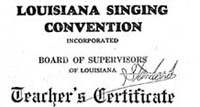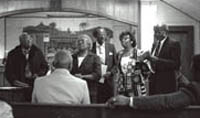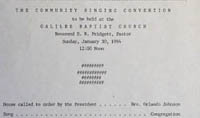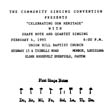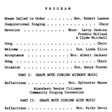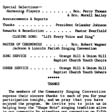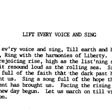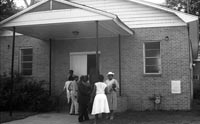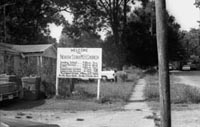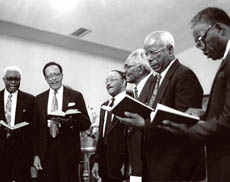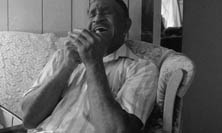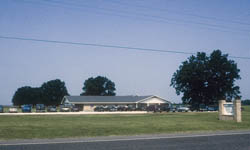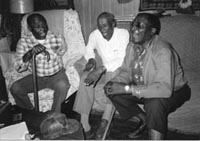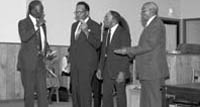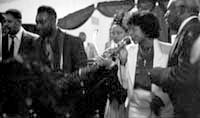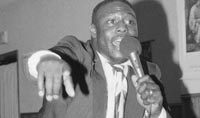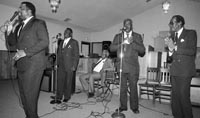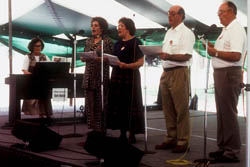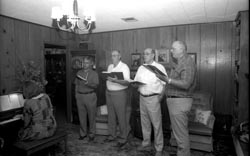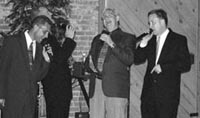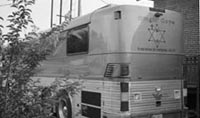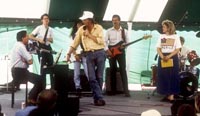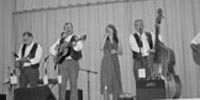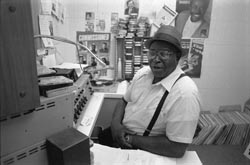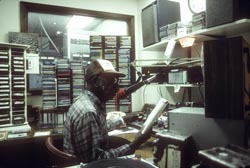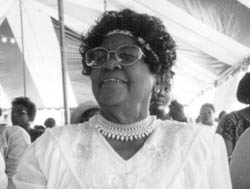Introduction to Delta Pieces: Northeast Louisiana Folklife
Map: Cultural Micro-Regions of the Delta, Northeast Louisiana

The Louisiana Delta: Land of Rivers








Ethnic Groups










Working in the Delta








Homemaking in the Delta




Worshiping in the Delta




Making Music in the Delta




Playing in the Delta







Telling Stories in the Delta



Delta Archival Materials
Bibliography

Sacred Music in the Delta: From Shaped Note to Quartet Singing1
By Susan Roach
Along rural roads across the flat Delta land and in towns from Lake Providence to Monroe, Winnsboro, and Ferriday, small wooden plantation churches and newer brick worship centers ring out on Sundays with uplifting, soul-touching sounds, echoing older music forms from earlier times. While much of the Delta has modernized, traditional sacred music still plays a major role in the Delta, especially those affiliated with a variety of Protestant churches. Protestant religious denominations found throughout the Delta parishes provide the context for traditional sacred music forms, which are passed along and learned informally in churches and families.2 Most of the sacred singers documented in the Delta project had no formal musical training, so most learned to sing "by ear," which means they learned the songs by listening to and imitating other singers. Many of the older generations did attend church-sponsored singing schools where they learned to read notes by shapes, but even those also sang by ear as well. Close harmony singing is valued, as are singers with a really good ear for those harmonies.
Sacred music traditions documented for the Delta Folklife Project include a wide variety of older sacred forms such as African American spirituals heard in Easter Rock, Dr. Watts hymns, shape note four-part harmony ensembles, four-part harmony quartets and ensembles performing with and without musical accompaniment, and congregational, choral, and solo singing with instrumental accompaniment such as organ and/or piano or a full band with guitar, bass, and drums. With the exception of a few of the songs heard in Easter Rock, the Delta's sacred music is comparable to that found throughout Louisiana and the South. While some of the songs are sung in both Anglo and African American groups, the performance styles differ because of the cultural group in which the music was learned. For the most part, in the Delta as in other parts of the South, Protestant churches have remained racially separated by preference because of these culturally different styles of worship. However, other race visitors or members are welcomed.
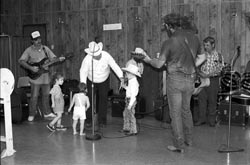
The contexts for the performance of sacred music vary as much as the music types. Sacred music has an important role in the typical Protestant worship services in both Anglo and African American congregations. In addition to Sunday services, special church events and rituals such as weddings and funerals usually include sacred music chosen for the specific event. Other performance contexts featuring sacred music are community music shows, family gatherings, local gospel radio shows, and benefits to raise funds for special causes such a community member's catastrophic illness or accident. Regardless of the context, the majority of the performers of sacred songs consider their musical talents to be "gifts from God" and their performances to be a form of religious worship, ministry, and testimony. The majority of the audio clips presented here are field recordings (mostly done with stereo analog recorders) of actual Delta church services, festival performances, and interviews with Delta musicians; thus one can experience the ambiance of the original performance context instead of a production made in more sterile recording studio.
Congregational Singing and Shape Note Harmonies
Much of the research on sacred music for the Delta Folklife Project was done by Annie Staten and focuses on African American shape note and quartet singing using four-part harmony with a seven-shaped note system.3 My research among African American and Anglo American Protestants, including Baptists and Mennonites, also revealed a strong shape note heritage. Learning to sing this type of four-part harmony was accomplished in the churches by imitating other singers and by learning to read the shapes of the notes. Most of the Delta shape note singers in Anglo and African American churches learned through the seven-note shape note system, called "do-sol-mi-do," which was a modification of the earlier four-note Sacred Harp system, also called "fa-sol-la" singing.4
In the early 20th century, the seven-note system was popular throughout Southern churches and taught by itinerant singing school teachers from both the African American and Anglo American communities. Singing schools held to teach sacred songs go back to the late 18th century when the four-note shaped system, also called the Sacred Harp system after the hymnal, The Sacred Harp, was used. The schools continued with the introduction of the seven-note system. Singing school teachers in the state typically took lessons through the Louisiana Singing Convention and received a "Teacher's Certificate." Schools were often sponsored by the Stamps-Baxter Music Company, established by Virgil Stamps and J. R. Baxter, who published sacred songs in both the old style and the newer gospel style. Books with new songs were published each year by Stamps-Baxter and other publishers.
One singing school teacher documented in the Delta Folklife Project, Sylvester Mason, was a favorite among African American congregations. Beginning his shape note career lasting over 50 years at age fourteen, he attended several singing schools held at the Little Bell Baptist Church while living on the Little Bell plantation in Perryville, Louisiana, and also learned some basics from his brother. According to Mason, the singing schools typically ran for two weeks and were taught by a travelling instructor with a shape-note rudiment book. William Sweeney, of Winnsboro, related his memories of learning shape-note singing from a singing teacher in Port Necessity at an event:
Back in 1925 in Port Necessity, Louisiana, James Avery moved into that community, and he was a man of do-sol-mi-do, and he organized a group; he first started in different homes, and he moved on to the church they called Morning Star, and they started singing do-sol-mi-do… . Then I really got into do-sol-mi-do, or got old enough; we was in Pleasant Star Baptist Church, … and some of the members there decided they would organize a vocal choir, and they got in contact with a fellow by the name of Essie Neals and he came down and organized and started us with do-sol-mi-do. The peculiar thing about it—so many people said, they couldn't sang—you know they was inviting people, and he had a way of telling you just what you could sing and where to sang and whatnot. He had what you call a tuning fork, and he had the shape notes run like you make the letter "A", running up and down. And he started singing, "Do, re, mi, fa, sol, la, ti, do, do ti, la, sol, fa, mi, re, do" [sings the notes going up and down the seven-note scale]. And then, after he do that, he could tell you what you sang: bass, tenor, soprano, alto, whatnot. So this is what this occasion is all about; it is much more that I could say, but I think that is fitting for tonight: Do sol mi do. ("Celebrating Our Heritage" 5 Feb 1995)
With the popularity of the singing schools and the growing number of song publications, singing conventions were held to teach the newer songs. Lasting a day or long, the singing conventions brought people together from the surrounding communities to "sing the new book," which they read by the shape of the notes.
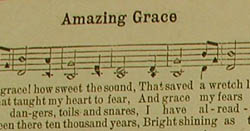
A number of different singing conventions were formed throughout North Louisiana Anglo and African American Protestant churches, including those in the Delta area, and met periodically to give singers a place to perform. Numbers of singers attending the conventions dwindled in the 1990s. Singers who attended the singing school classes and the singing conventions learned to read the notes in hymnals by their shapes; after they learned how to read the music by the shapes, they also brought in new songs into congregational singing. Traditionally, in Protestant churches, hymnals contain songs with words and music written in four parts: soprano and alto for women and tenor and bass for men.
The most common context for performance of the shape note singing was the regular church services on Sundays; typically these were held weekly on Sundays, but in some of the rural churches, these services might be held semi-monthly or on another schedule, depending on whether a pastor was available. Most of these services have a "song service" sung by the congregation and/or the church choir; songs are selected for the different stages of the service, such as the call to worship, invitation, and communion. The song leader choosing the songs generally sings lead (soprano).
While most of the songs are performed with the use of hymnals, in some groups, songs are lined out. Even the lined out hymns may be sung in parts. African American Baptist churches usually open with a song sung in unison, followed by a devotional service, which includes a lined-out hymn, a scripture reading, and prayer, followed by another hymn. For example, when Annie Staten arranged a special program entitled "Celebrating Our Heritage with Shape Note and Quartet Singing," the elders led the devotional, which began with reading the 23rd Psalm, followed by "raising," or beginning to line out the hymn "I Know the Lord Will Answer Prayers," and a prayer, accompanied by moans from the song.
After the devotional service and another song or two (or a longer song service in some churches), the minister delivers a sermon, which is followed by a song of invitation to join the church. An example of a song of invitation after the minister's sermon is provided by North Star Baptist Church in Lake Providence, led by its late pastor, Reverend A. L. Thomas, whose deep, resonant voice provides a context for the old hymn "Amazing Grace," which was used as the song of invitation after his Sunday evening sermon at North Star Baptist Church in Lake Providence. The rest of the typical Sunday service varies according to the Protestant group.
If the church holds any additional rituals such as communion, baptism, or other services; appropriate songs will be chosen. For example, when a new member was voted into the North Star Baptist Church, Reverend Thomas had the other ministers come forward to "extend the right hand of fellowship" to the new member while the choir performed an upbeat version of "Leaning on the Everlasting Arms" (Elisha A. Hoffman, 1887) in unison, while the choir director called out the lyrics for each line, and the choir responded. Usually, congregations sing a closing hymn such as "Blest Be the Tie that Binds," which is followed by a closing prayer.
One of the last African American groups practicing shaped-note singing in the Delta in Franklin Parish in 1994 was the Winnsboro Senior Citizens, as they called themselves for the "Celebrating Our Heritage" event. The group included Roosevelt Bowie, Henry Hardin, Mose Jones, William Neal, John Norwood, Roger Richardson, William Sweeney, and Percy Thomas. These members all grew up in the shaped-note tradition.
Percy Thomas, one of the Winnsboro Senior Citizens, also played the harmonica for church and community events around Winnsboro. While he played for dances in the past, most of his contemporary performing was in religious settings. Calling his talent of harmonica playing a "special gift from God," Thomas learned to play by listening to cousins in his family when he was about twelve years old. He purchased his first harmonica for twenty-five cents. He went on to collect other harmonicas, including his "Big Baby," which cost him $35. In his performances at church or home, he typically played tunes such as "I'll Fly Away," or blues-style songs such as the old "Nobody's Fault but Mine," in which he would sing a verse himself and then punctuate it with harmonica rifts. His wife Estelle often sang along with him on songs such as "I'm Gonna Jump and Shout When I Get Home." When she sang with him, he would play through the whole song.
A husband and wife duo, Orlando and Ceola Johnson, from Start in Richland Parish, were well known in the shaped note circles. Orlando Johnson began his singing career in 1922 with lessons from a travelling music teacher, W. P. Pointer. Johnson learned to read music from him with the seven-note shape system. After marriage, the Johnsons began singing together and became members of the quarterly Community Singing Convention, an African American shape note association in Richland Parish.
Although they had their own shape note teachers apart from the African American and Anglo American singing schools, the Mennonites in East Carroll Parish still maintain a strong shape note singing tradition. In the 1960s-70s to complete the final leveling of the Delta for growing soybeans, specialists in land leveling moved in from the mid-western states, Kansas in particular.
Among those heavy equipment experts were members of the Church of God in Christ Mennonite Church, including the family of Marlin and Kathy Wedel, who made their home in Transylvania in East Carroll Parish. They opened their Olde Dutch Bakery, which featured their Mennonite recipes. For the Wedel family, sacred music serves as a means of worship, ministry, and even entertainment. Kathy Wedel says, "They sing a lot; that's our life."
Congregational a cappella hymn singing has a major part in the Mennonite church services. Hymns are sung to open and close worship services and to precede the sermon, communion, and other parts of services. Periodically, the church holds special "song services," in which the congregation meets for an evening of singing together. Typically, there are no solos or choirs except in the case of special rituals such as weddings, where there may also be an ensemble.
Even in weddings there are congregational hymns; for example, the wedding of the Wedel's daughter, Rachelle to Mark Lerd had congregational hymns, including all the verses from the 18th century hymn, "Come, Gracious Spirit, Heavenly Dove," directed by a song leader from shape note hymnals.5
Regarding the hymns as a ministry and a means of their evangelical work, the Mennonites also take groups of singers into area nursing homes to sing for the elders there. Singing also provides comfort, as Kathy Wedel expresses it, "There's more in songs that touch a heart than words do." For example, when a man in their community was dying of cancer and the family went to see him, he requested that they sing for him. They also frequently sing for funerals in the community. In their former bakery, in Lake Providence, visitors often heard bakery workers singing hymns as they worked. In their home life, singing a cappella hymns is a common pastime, especially on Sunday afternoons after a large family meal. This was the context for the songs presented here by family members including Marlin and Kathy Wedel, their son Dale and his wife Elaine, their daughter Trish and her husband Wayne Unruh, daughter Rochelle Wedel, and friend Sarah Saul.
The type of music sung in all these contexts is a cappella, sung by reading the shapes of the seven notes in their shape note hymnals. Dale Wedel, son of Marlin and Kathy and a song leader in the Mennonite Church, explains how they sing the songs in the hymnals:
They read the shape of the notes, not the placement on the staff… . This is very similar to learning another language. When you learn another language, you think that language; you don't have to translate everything. It's kind of that way when you sing. We see the notes, and we just follow them as we see the shape, we just follow it, and we know what we're singing because we are used to singing the notes. But you don't just have to concentrate really heavy on it unless you are learning the song. Now if you are learning the song, then you got to concentrate on timing and on the notes and the words; it's a little trickier… . You learn that [the timing] by the amount of beats per measure, and we follow that. You might have seen us keeping track; I'm a song leader, so I keep track with my foot all the time. I'm just used to doing that; otherwise, you just slow down and speed up and all that in the song. This way you can kind of keep it; it keeps a rhythm in your head without even really having to concentrate on it; you feel it.
Song leaders such as Dale Wedel, learn how to conduct the different time signatures by beating the time with the hand and use a pitch pipe to begin and sing first notes of the different parts: tenor, soprano, alto, and bass. Some of the older songs, such as "Are You Washed in the Blood" are sung more often in church services.
Another favorite song also had a theme of the transformation experienced through salvation: "I've Been Changed." Sometimes the parts are sung lower or higher than they are written. For example, in a song sung by a trio of women, such as "Promise Me," Rochelle Wedel sings low soprano an octave lower than the song is written, while Sarah Saul sings the alto part an octave higher. Trisha Wedel sings the tenor as it is written.
In addition to singing songs from their published hymnals, the family also cherishes songs written by members of their own church. They have their own folders full of copies of sheet music that they love to sing. Robert Toews, who used to live in their community, wrote one of their favorites, "Love Will Bring Us Together." Another favorite song, "If I Had 10,000 Tongues" was written by Marilyn Smith, the mother of one of their close friends in Mississippi.
Quartet Singing
Influenced in part by the shape note singing and its singing conventions and the national gospel movement led by Thomas Dorsey, African American quartet music was on the rise in the 1920s. The late 19th century barbershop quartets had died down in popularity, but would revive in the 1930s to contribute to the popularity of close harmony singing. Reverend Alphonso Calloway, who has performed in quartets in every state but six, attributes the beginnings of quartet singing nationally to the jubilee songs sung by groups such as the Dixie Hummingbirds, the Fairfield four, the Blind Boys, and the Swan Silvertones. While some groups did eventually add music, he notes that most of their singing was done a cappella: "Most of us used our mouth to make the tune or music we were going to make. We had one mike, and we would hover around one mike; that way if bass, tenor singer, baritone singer, or lead singer made a mistake with all of us being huddled up there, it was hard to tell which one it was because most of us would keep on going" ("Celebrating Our Heritage" 5 Feb. 1995). While the heyday of the quartet tradition in the Delta region was during the 1950s and lingered on into the 1990s, as Sam Woods, of Monroe, explained to Annie Staten in 1993, choirs were beginning to take their place. Willie Scott, a member of the Mighty Soul Guides, defines quartet as "four voices blending together making music as well as instruments and vocal: lead, tenor, baritone, and bass" (Mighty Soul Guides, 19 Jan. 1994).
Of course, many quartet singers had learned the basics of harmony singing through the shape note singing schools. Certainly, for singers growing up in the 1950s, secular doo-wop groups, which mainly grew out African American and Anglo American gospel, in turn, helped popularize gospel quartets. For the most part, the tradition of quartet singing was passed on informally by observation and imitation. James Douglas, a member of the Royal Newtown Spirituals, relates how his son also became an avid quartet singer: "Well, he just grew up around it, and every time I would go to singing, he was there with me, so he was about two or three years old. He was just standing on the floor,[and he] come up to where I was. So it was just something that was there, you know" (Royal Newtown Spirituals, 1 Dec. 1993).
When quartets were programmed as guests to perform in other churches, the host church had to raise funds to pay the quartet's expenses. This was accomplished in various ways. The group was usually paid by splitting funds raised by the church hosting the event. When the group performed in their hometown, they received fifty percent; when out of town, they got sixty percent. All the money was put back into the group expenses such as transportation, instruments, outfits, etc. (Royal Newtown Spirituals, 1 Dec. 1993). James Douglas recalls another means of raising the funds:
I remember they used to do a Penny March… . A lot of people would get pennies in their hands, and they would march out. They would just march around until they had emptied their hands [at the altar in the collection container]… . They would do that, a lot of time, your offering time was part of the service. And they took it as pride too. As the congregation marched up to the altar, they sang a song while the quartet took a break. (Royal Newtown Spirituals, 1 Dec. 1993)
Another means of raising funds was to designate queens to take up collections for the quartets. This was a tradition for the Delhi quartet, the Four Pilgrims, one of the oldest quartets interviewed. Group manager Eagles Anderson, notes that frequently, up until the 1970s, the quartet would have "queens" selected by the hosting church to take up collections to pay expenses for the group.
Among the African American quartets that were popular in the Delta are six that were documented and presented at the "Celebrating Our Heritage with Shape Note and Quartet Singing" by Annie Staten: the Four Pilgrims, the Pleasant Star Singers, the Convention Specials, the Hawkins Family, the Royal Newtown Spirituals, and the Mighty Soul Guides. A look at these groups, their members, and performance excerpts from this event provides examples of the Delta African American quartet tradition.
From 1938 to 1987, the Four Pilgrims Quartet, from Delhi, in Richland Parish, was a popular African American group across the Delta. Performing a cappella and using their voices and hands and feet to keep time with the music, the group included Eagles Anderson (lead and group manager), Louis Harrington, Frederick Pearson (tenor), and William Boston (joining the group about 1951). Over the years, the two constant members were Anderson and Harrington, but other members of the group changed. The men were active members of their churches and were all sharecroppers on plantations around Delhi. The quartet traveled mostly on short trips to Louisiana, Mississippi, and Arkansas.
In those days, finances for the group were slim, but according to Anderson, they would sing even if they received low or no payment. Any money they received was held until their anniversary of the group formation; then they would pool the funds to purchase new matching suits, which gave them a professional look and matched their professional delivery, featuring introductions to their songs and a closing theme song.
The group notes that most of their special performances were well attended, but sometimes they would have a small congregation; nevertheless, they sang the same songs with the same intensity. Harrington emphasizes, "We was not singing for just people; we sing for God" (Four Pilgrims 4 Dec. 1993).
Formed in 1946, the Pleasant Star Singers from Winnsboro, in Franklin Parish, is one of the older a cappella quartets in the area. Group members include Mose Jones (lead and bass), William Sweeney (tenor), Percy Thomas (background), and Albert Jackson (lead). Named after the Pleasant Star Baptist Church, where they were members, the group performed in churches throughout the Delta and in nearby states until 1955. Then members of the quartet joined other quartets and continued singing until 1985. In 1994, they reprised their quartet performances at the Celebrating our Heritage event coordinated by Annie Staten.
The Convention Specials Quartet, from Monroe, in Ouachita Parish, was formed to support the Louisiana Song Leaders convention, which met second Sunday of each month and rotated among several Delta churches. This group worked to keep the spirit of the old singing conventions alive. Performing with or without instrumental accompaniment, members of the quartet include Reverend Alphonso Calloway, Reverend Keyes, Reverend Samuel Jackson, Deacon Albert Jackson, and Henry Staten, musician. All members of the quartet were formerly associated with other quartets.
The Hawkins Family, a quartet from Bastrop, in Morehouse Parish, got its start when T. J. Hawkins, began singing professionally at age 23 with area quartets. As his children grew up, they began singing with him and his wife Mizell and formed a family quartet. When they sang at the 1994 Louisiana Folklife Festival and again in 1995, the group included nine children and two grandsons. They sing four-part harmony accompanied by guitars and keyboard in a highly spiritual upbeat style in area churches and as far away as Houston, Chicago, and Dallas. In the earlier days of the quartet, the quartet often sang a cappella as they demonstrated for Annie Staten in their interview with her. When they performed, they frequently opened with their theme song, "Every Time I Think about my Blessings, I Think about Jesus."
The Royal Newton Spirituals, from Monroe, in Ouachita Parish, began with Sam Woods, quartet leader, and James Douglas II in 1956. Although most of the original members no longer sing with the group, the two men have kept the group together by adding new members when openings arose. The group members in 1994 included Sam Woods (leader and bass), James Douglas (baritone), Larry Rawlings (lead and keyboard), Bruce Richmond (lead tenor and guitar), Clint Wiley (bass guitar), Tommie Reed (drums), and Tyrone Wood (tenor).
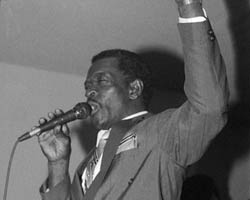
Sam Woods, whose background is representative, explains that he came to quartet singing by hearing quartets at church and on the radio, such as the Fairfield Four; this made him want to try it himself. While in the early years, the quartet mainly sang a cappella, today they sing with instruments primarily; however, they still perform a cappella to inspire their younger members to stay in touch with their heritage. They frequently perform in area churches as well as monthly as part of the Monroe Big Four, a regularly-held concert in Monroe featuring four area groups. When Woods was asked what kept the group together, his answer was "prayer," indicating the strong religious belief behind the tradition.
Woods outlines what he looks for when considering someone for membership in the quartet: "We want to know if he's a member of the church first, and then the next thing, we want to know if he's dependable. And then we need to know what part he sings." Both Douglas and Woods feel like quartet singing played a vital part in their lives; as Douglas expresses it, "If I hadn't been with quartet singing, I don't know quite what I would have been doing because … I could be in the street and doing anything. It kept me busy, kept me out of street, and kept me interested" (1 Dec. 1993). Sam Woods expresses his feelings for the sacred quartet tradition: "I love it. I have been in this all of these years. Every time I thought about just stepping down, it's just something there that won't let me. So I got to keep on going… . You don't get paid for starting and stopping; you got to do until the end" (1 Dec. 1993).
The Mighty Soul Guides, from Rayville, in Richland Parish, were also called the Four Pilgrims, Junior in their early years. The quartet includes Leroy Jenkins, of Rayville (manager and tenor and guitarist), Willie Scott, Jr. of Rayville (baritone), Ernest Gaines of Rayville (lead singer), Charlie Brown III, of Newellton (lead singer and keyboard), Gerald Scott of Monroe (vocal), and Chauncey Robinson. Three of the singers are from three generations of the same family: Willie and son Gerald Scott and Chauncey, Willie's grandson.
Manager Leroy Jenkins and Willie Scott had many years of experience singing with other quartets, some who sang a cappella. Typically using instrumentation in their quartet, the group was in demand to sing at area Delta churches and other community events held at school and civic auditoriums. The group's goal is to sing in a spiritual manner and lift the name of Jesus through their songs. Two of their members have become ministers.
While less research on quartets was conducted among Anglo American Protestant churches, the four-part harmony tradition is also strong among this Delta group. Inquiries in every town or church will reveal area favorites such as the Men's Quartet at the First Church of God in Oak Grove, also known as the Oldham Family, since this family forms the core of the group. Many church-based quartets now include musical instruments, especially the piano. Some groups such as the Gerald Lewis Singers include a full band with piano, drums, and guitars while continuing to perform in a basic gospel style. Many of the newer quartets are using pre-recorded music, either with their own instruments or in pre-recorded cd tracks for vocals. In addition to standard church quartets, other groups, such as the Brothers in Christ form to bring their ministry to other venues outside of churches. Groups such as this frequently perform at benefits for individuals as well as helping non-profits for philanthropic causes. In addition to a cappella shape note and quartet sacred music, another important sacred style featuring close harmonies is bluegrass gospel. Performed in both secular bluegrass jams and festivals, bluegrass gospel ranks high in the repertoire of Delta bluegrass musicians, such as Southland. All these different styles of gospel groups focus on singing harmony and believing in the significance of the words they are singing.
The Men's Quartet at the First Church of God (The Oldham Family), from Oak Grove, in West Carroll Parish, an English-Scots-Irish quartet, sings hymns learned in shape note singing schools with the newer seven-note shape note system. Two brothers, Alvin and Marvin Oldham form the base of this men's quartet. Two non-family members, Stanley Irby and Cat Durbin, complete their quartet, and sister-in-law Glenna Oldham, married to Alvin, plays piano for them. When she's in town, their sister from Baton Rouge joins them.
The current group, like many other quartets in the region, continues to perform for church services, funerals, and in nursing homes. They were also favorites on the gospel stage at the Louisiana Folklife Festival in Monroe from 1994-2004. Songs in their repertoire include "Beulah Land" (a typical funeral song), "I Feel Like Travelling On," "On the Jericho Road," "My Jesus, I Love Thee," "Where Could I Go," "I Am on the Altar," "I'm Winging My Way," and "Hand in Hand with Jesus," just to name a few.
According to Glenna Oldham, the quartet's history goes back to Marvin and Alvin's mother, Lilla Pearce Oldham and reaches across the parish. Their mother, Lilla Pearce Oldham, came from a family of singers; her brother, Logan Pearce, taught shape note singing school, and their Uncle Dave Pearce, who served two separate terms as the Louisiana Commission of Agriculture, was also a well-known gospel quartet singer from the parish. In fact, the Dave L. Pearce Memorial Gospel Sing, held annually in March in Oak Grove, was established in his honor. Glenna Oldham explains how the family singers served the community over the past generations:
The parish has leaned on them. I know when your mom, Marvin, was living and probably when Uncle Dave was here, [they] often sang for funerals and special occasions. They would get called on to be in charge of the music. Now that Mamaw [Lilla Pearce Oldham] is not here, Marvin is called on. The whole parish has relied on them down through the years wherever, whether they was at this church or at Pioneer or whatever or that is kind of the way I look at it. Since I was a child and everybody I talked to, the parish relied on the Pearce's and the Oldham's to be leaders in gospel music for this area. (Oldham 6 Aug. 1994)
With this history and the dedication of Lilla Pearce Oldham, a great alto singer, it is not surprising that her sons remained dedicated to quartet singing and harmonizing and conscious of characteristics of quartet aesthetics. Marvin Oldham explains what makes a good quartet:
I think what it has to have is the four people who are trying to harmonize with each other and not trying to outdo the other. Just sing loud enough to hear yourself, but able to hear everybody else too. It is real compliment when people ask you after a quartet special who was singing that particular part. That is a compliment. (Oldham 6 Aug. 1994)
In addition, he thinks that "good accompaniment" is important. The group always uses a pianist and does not like to use recorded music. Cat Durbin justifies the reason for this: "I personally would rather have a live performance because if we mess up, she [Glenna Oldham] can cover it up. If we lose our place on a tape, it is kind of difficult at times to come back in the right spot and get everybody synchronized" (Oldham 6 Aug. 1994). Glenna Oldham adds, "You have to have joy… . You have to have guys that love it. It comes out sounding better when they love it" (Oldham 6 Aug. 1994).
While they usually stick with the music as it is written, they do improvise, as Glenna Oldham explains:
I would say that you all stick to the music because you can really stay together better that way. But some little things that we do is maybe repeat the same line, maybe do a line a cappella, maybe let one person do a solo part on a verse, and then sometimes combine two songs and work them and have sung a verse of one song and then they will go right into another song. But that basically is it. I think they stick with the music pretty good, but you know, occasionally you want to put a verse or hold a note that is a quarter note for four beats or everybody marks there music or let's breathe here, and everybody marks their music. It has to be planned; it can't be spontaneous when you get up there. (Oldham 6 Aug. 1994)
While they are serious in their performances, they also have a humorous side and frequently joke around, especially when performing at nursing homes. They also do some secular numbers. One humorous number they call a "ditty" that they sometimes perform plays with singing harmony off key and is a parody of an old commercial for Warren paint, a former paint brand.
Giving their mission on their web site as "A Christian Music Ministry," the Brothers in Christ, a.k.a. The Singing Cops, from Monroe, in Ouachita Parish, combine a traditional family Southern gospel quartet vocal background with their own contemporary instrumental music arrangements recorded by Nashville musicians. They are popularly known as The Singing Cops because of the majority of their occupations.
Group leader and baritone, Larry Ellerman, is Chief of the University of Louisiana-Monroe Police. He and his wife Claudine, both from northeast Louisiana, actually were members of an earlier quartet—Sounds of Praise, so quartet singing is a long-time family tradition. Their son Jay, lead vocalist, is a deputy for the Ouachita Parish Sheriff's Office. His son Jerry, bass in the group, is a detective. Another son, Jeff, who sings first tenor, is an occupational therapist. Their cousin, Mark Kemp, who is also in police work, sings second tenor.
Most of their performances include new songs, performed by major Southern gospel performers such as the Gaithers. Their Nashville arrangements and song selections reflect their strong Southern gospel sound in numbers such as, "I've Never Been This Homesick Before" by Dottie Rambo.
Occasionally, in their performances, they will sing an older a cappella number such as the old traditional spiritual, "In that Great Gettin' Up Morning," featuring their timing and close family harmony. Equipped for regional touring with a large family bus, they perform their music ministry throughout the southern United States for churches, benefits, and other gospel gatherings.
The Gerald Lewis Singers, from Swartz, in Ouachita Parish, was formed by Gerald Lewis, who grew up in Ferriday, Louisiana. Following in the footsteps of the family, he learned to play piano with his cousins Jerry Lee Lewis, Mickey Gilley, and Jimmy Swaggart. While his cousins turned to rock 'n' roll, country music, and television ministry, Gerald Lewis became a minister in rural Assembly of God churches; according to him, his churches were always six miles from somewhere.
His group's first festival performance was at the 1995 Louisiana Folklife Festival. When he performed at the 1997 Louisiana Folklife Festival, he was an Assembly of God minister at Swartz, six miles from Monroe. He also performed at the Smithsonian's 1997 Festival of American Folklife and was featured in Robert Mugge's film, Rhythm 'n' Bayous. While he does not have a typical quartet, his singers still sing harmony to his lead and includes Lewis on piano, along with musicians and singers Billy Bailes, Allen Eppinette, and Donna Dobbin.
According to a 2014 news article, Lewis recently celebrated fifty years as an ordained Assembly of God minister, and still includes music in his services—a fact that contributed to his induction into the Northeast Louisiana Music Hall of Fame in West Monroe. He states in that article, "Yes, I play every Sunday. If I feel the urge (during services) I'll go over and play 'Feeling Mighty Fine.' Last Sunday I said 'I think I'm going to play one, going from pulpit to piano.' I say I'll play long and preach short" (Young).
Bluegrass Gospel
In addition to a cappella shape note and quartet sacred music, another important sacred style featuring close harmonies is bluegrass gospel. Performed in both secular bluegrass jams and festivals, bluegrass gospel ranks high in the repertoire of bluegrass musicians in the Delta. Southland Bluegrass, formed in 1971 by Jimmy Nugent, from Hickory Grove, near Deville and Catahoula Lake, and including family members and one of the most popular bands in the region, often performed gospel and recorded all-gospel albums, such as their CD Amazing Grace. Like most bluegrass groups, their sacred numbers also include bluegrass instrumentation with banjo, guitar, mandolin, and bass and four-part vocal harmonies.
Their version of the old song, "I Feel Like Traveling On," written by William Hunter in 1838, is representative of bluegrass gospel. A lead singer sings the verses of the song and is joined by other band members singing harmony on the chorus. The family band, as documented in 2000, featured six musician who took turns singing lead and harmony: Jimmy Nugent, playing bass and singing lead and harmony; Brice Nugent on guitar and bass vocals, Roy Nugent, playing guitar and singing lead and harmony, Alecia Nugent McRight singing lead and harmony; Raymond Nugent on mandolin, and Julius Elsey on banjo.
Gospel on the Radio
The Delta has also had its share of African American gospel radio shows that provided another venue for local gospel performers. Popular in the African American communities across the Delta, these radio shows not only offered a live showcase for local performers of sacred music but also gave the performers themselves easy access to national recordings, which influenced their local repertoires. These radio shows had local hosts who were tuned in to the local gospel scene. Delta gospel show host personalities who were documented over the years include Reverend A. L. Thomas, of Lake Providence; Roosevelt Savannah, of Swartz; and Pearlee Tolliver, of Monroe. All of these got their start in radio through their own gospel singing.
Reverend A. L. Thomas, a native of Lake Providence, sang in a quartet during the years prior to becoming a minister. Thomas's statement regarding his musical talent is typical of many of the gospel singers, including preachers, in the Delta: "I could always sing by ear. I can't read music, but if I could hear it, I could always hum a little tune" (Thomas 22 Aug. 1989). He and some young friends in church often got together to sing and formed an a cappella quartet in 1955 quartet, the Stars of Joy, and even travelled as far as Memphis and Chicago and sang a number of years on the local radio station KLPL and the Monroe television station KNOE on a gospel program sponsored by the Wilson Manufacturing Company and its Wilson Indian Bitters. When he gave in to a long time divine call to preach in 1971, Thomas did not have enough time to devote to quartet singing. However, after he became a preacher, he continued to host a gospel show on the local radio station in Lake Providence.
Another radio personality in the Monroe area, Roosevelt Savannah, or Rosey as everyone knew him, performed for over fifty years on both sides of the Atlantic. Although he was versatile in a wide range of genres, including opera and musical theater, he returned to Swartz in Ouachita Parish to sing country gospel in a traveling ministry and had a radio gospel show.
Probably the best known radio host in the region, Sister Pearlee Tolliver, known as the "Jewel of the Dial," hosted a her weekly radio gospel show on various AM radio stations and the FM station KYEA in Monroe until her death in 2002. Her memorable ad style and her closing phrase, "Why not check it out and lock it in?" endeared her to many, creating a vast network of fans, and meriting her an article in the New York Times at her death (Strauss). Because of the unique commercials she wrote and ran during her radio show, she was included in Robert Mugge's film, Rhythm and Bayous: A Road Map to Louisiana Music. Commercials from Pearlie Tolliver's show are available on NPR's All Things Considered, 10 Sept. 2002: a video clip from Robert Mugge's film with Pearlee Tolliver, Gerald Lewis, and Easter Rock is available. For several years, Tolliver also served as a celebrity announcer on the Gospel Stage for the Louisiana Folklife Festival, thanks to former festival director, Mike Luster, who also documented her shows. Luster sums up her career:
From her early days as a member of the Jordan Singers who recorded for Chicago's Checker Label to her final days of her long run as the undisputed queen of gospel radio in northern Louisiana, Pearlee Tolliver touched untold lives with her warmth and enthusiasm. Her fans were legion and included many such as Billy Gibbons of ZZ Top, Ben Sandmel of the Hackberry Ramblers, and Marcia Ball who collected tapes of her program and recited her catch phrases and unique elocutions. (Luster 2014)
Conclusion
While the gospel styles of the Delta sacred music performers may sound quite different, all the performers believe in the spiritual message they are delivering in song and consider their singing a ministry and a gift that they are obliged to share. For performers and most audiences as well, this belief may be the most compelling aspect of their performance. Even when gospel singers perform in a secular event such as a folklife festival, both the performers and audience may transcend the performance context and take it to a spiritual level. While most of the religious services in the Delta are racially separate, that segregation does not mean that performers do not appreciate each other's music; they just may not be able to sing it themselves.
The Delta Folklife Project made it possible to identify and document these different treasures of Delta sacred music. Produced through training from the Delta Field School, Staten's research and presentation of the "Celebrating Our Heritage" events in the African American community, in particular, helped to make the younger African American community aware of their traditions on the local level. In addition, the research ultimately provided a previously untapped pool of Delta musicians to be presented in the secular public context of state and national folklife festivals, creating more global awareness of the traditions. Most of the groups here were presented at the Louisiana Folklife Festival in Monroe from 1994-2004; some were also presented at the 1997 Smithsonian Festival of American Folklife, which featured the Delta, and even the New Orleans Jazz and Heritage Festival. None of the documented groups had been presented in such a context before; only a few more established groups such as Southland had performed in bluegrass festivals or community festivals. Programming a series of gospel styles in the festival context provided a means to compare styles and also gave performers a chance to hear each other. Most of them had not met before. Singers who were programmed for the Washington D. C. Smithsonian festival were able to listen to each other's music and interact over two weeks.
One extraordinary result of such interaction was recorded in the Gospel Tent at the 1997 Louisiana Folklife Festival in September, just two months after the national festival where the Delta had been presented. Gerald Lewis, a white Assembly of God minister, is nearing the end of his performance with his group when he spots the arrival in the tent of the powerful African American gospel singer Penola Caesar, who would perform next. Although Lewis and Caesar lived within twenty miles of each other, they had not met until the state and national festivals. Because traditional musicians such as Lewis and Caesar sing by ear and can improvise easily, such impromptu jam sessions are fairly common. However, it is much more common for musicians to jam when they perform the same style. Lewis praises her: "Mrs, Penola Caeasar—she's going to bless you after 'while; she sings those good gospel songs; in fact, before we go off, I want her to come up and sing a song; we're going to sing one more; can we maybe squeeze in another—one song and get Sister Penola Caesar to come up and sing "His Eye Is on the Sparrow and I Know He Watches over Me" (Louisiana Folklife Festival Gospel Tent recording 13 Sept. 1997).
Lewis had heard Caesar perform this song before in Washington, and it is also one of Caesar's favorite ones since it was often sung by her favorite singer, New Orleans-born Mahalia Jackson. The song echoes the joy they derive from singing and their Christian belief in their personal relationship with God through Christ and his care for the smallest creatures: "I sing because I'm happy; I sing because I'm free. His eye is the sparrow, and I know he watches me."
Beginning as two artists in separate performance modes, Lewis and Caesar create a single artistic statement in one of the great moments in the Delta Folklife Project. The fact that the two work so well together illustrates the extent of their common religious belief. Though they are both spirit-filled singers, they are from two different cultural traditions, but that difference produces an amazing creolized performance of Delta gospel music when Lewis invites her to the stage: "Sister Penola Caesar, come sing your song for us, and when she sings the verse, we're going to probably jump in on the chorus and help her with a little bit of the musical part of it. This lady can sing like nobody I've ever heard; I'll tell you. Whooo, you're looking good girl!" When he asks her if she knows what key she does it in, she responds no, and he says, "We'll find you; just hit it"
Graciously accepting his invitation, Caesar opens with a slow, soft a cappella verse, filled with melisma and improvised wording; Lewis responds to her song, "Ooh, yes" and echoes his response, "I know" and "he watches" to some of her phrases; much like she would hear in her own church. As she begins the chorus, he gauges her key perfectly, and floats in with lyrical understated piano. As her singing becomes more rhythmic in the chorus, the rest of the band and singers join. Donna Dobbin belts responses to Caesar's phrases with raspy-voiced harmony, and the band picks up the tempo. Their music builds into a crescendo. It is an incredibly moving performance full of religious fervor that ends in a Delta signature with a Lewis family-style piano flourish and Caesar's resounding "Hallelujah!"
Notes
1. This article could not have been written without fieldwork from Annie Staten; the cooperation and talent of the gospel singers; other research and materials from Stefan Keydel and Mike Luster, former directors of the Louisiana Folklife Festival in Monroe; and photographic and editorial assistance from Peter Jones and Maida Owens. I also appreciate help with transcriptions from Louisiana Tech University assistants, Ross Todd and ZiYi Jiang.
2. For contextual information on African American religious beliefs, values, and practices, see Jackson's article "Songs of Spirit and Continuity of Consciousness: African American Gospel Music in Louisiana" http://www.louisianafolklife.org/LT/Articles_Essays/songsspirit.html
3. I am indebted to Annie Staten for her research on African American quartets and shape note singing. In addition to interviewing a number of singing groups and attending their performances, she made great effort to showcase these traditions in area churches in Monroe and Winnsboro in a special event, "Celebrating our Heritage," which she coordinated. Staten located many of the groups, conducted interviews with them, and wrote brief sketches of the groups which have contributed to this essay. Another researcher, Stefan Keydel, director of the Louisiana Folklife Festival from 1994-1995 also documented Roosevelt Savannah, Percy Thomas, and the "Celebrating Our Heritage" events coordinated by Annie Staten. For further description of the African American Baptist church service see Bailey (4) and Dargan (27). Other research contributing to this project is my own interviews and documentation of Mennonite singing traditions in the Wedel Family, Easter Rock, some benefits, and a few Anglo-American groups through the Delta Folklife Project and the music gathering project for the Regional Folklife Program. Because of the differing lengths of interviews with the various performers, descriptions vary in depth and length.
4. See George Pullen Jackson's Story of the Sacred Harp for details on the development of this important historic form of music.
5. Hymns sung in the Delta Mennonite Church generally include all verses of each song as printed in the hymnal.
Works Cited
Armstrong, Harry P., ed. Spiritual Life Songs: Shaped Notes. Nashville, TN: Cokesbury P, n.d. 17-19. Print.
Bailey, Ben E. "The Lined-Hymn Tradition in Black Mississippi Churches." The Black Perspective in Music, 6. 1 (1978): 3-17. Web. 30. Dec. 2013.
Brothers in Christ. Web. 14 May 2014. http://www.bncministries.com/index.html
---. Performance at Keep Dubach Blooming Benefit. Dubach, LA. 2 June 2000. Audio recording by Susan Roach.
---. I Hear His Voice. n.d. CD.
"Celebrating Our Heritage with Shape Note and Quartet Singing." Community Singing Convention, Union Hill Baptist Church (Song Service coordinated by Annie Staten). Monroe, LA. 4 Feb. 1995. Audio recording by Susan Roach.
Community Singing Convention. Galilee Baptist Church, Start, LA. 30 Jan. 1994. Audio recording by Susan Roach.
Dargan, William T. Lining out the Word: Dr. Watts Hymn Singing in the Music of Black Americans. Berkeley, CA: University of California Press, 2006.
Four Pilgrims Quartet: Eagles Anderson and Louis Harrington. Personal Interview by Annie Staten. 4 Dec. 1993.
Hawkins Family. Personal Interview by Annie Staten. 5 Jan. 1994.
Jackson, George Pullen. White Spirituals in the Southern Uplands. Hatboro, PA: Folklore Associates, 1964.
---. White and Negro Spirituals. New York: J. J. Augustin, 1943.
---. The Story of the Sacred Harp. Nashville: Vanderbilt U P, 1944.
Jackson, Joyce Marie. "'Like a River Flowing with Living Water': Worshiping in the Mississippi Delta." Delta Pieces. Louisiana Division of the Arts. Folklife in Louisiana: Louisiana's Living Traditions, 2014. Web. 15 May 2014.
---. "Songs of Spirit and Continuity of Consciousness: African American Gospel Music in Louisiana." Louisiana Division of the Arts. Folklife in Louisiana: Louisiana's Living Traditions, 2014. Web.15 May 2014.
Louisiana Folklife Festival Gospel Tent Recording: Gerald Lewis with Penola Caesar. 13 Sept. 1997.
Luster, Mike, ed. 1997 Louisiana Folklife Festival Program Book. Monroe, 1997.
---. "Re: Pearlee Tolliver." Message to the author. 26 May 2014. Email.
Mason, Sylvester. Personal Interview by Annie Staten. 8 Jan. 1994.
Mighty Soul Guides Quartet: Leroy Jenkins, Willie Scott, Earnest Gaines, Charlie Brown, III, and Gerald Scott. Personal Interview by Annie Staten. 19 Jan. 1994.
North Star Missionary Baptist Church Service, Lake Providence. 27 Aug. 1989. Audio recording by Susan Roach.
Oldham Family Quartet. Personal interview. 6 Aug. 1994.
Rhythm and Bayous; A Road Map to Louisiana Music. Dir. Robert Mugge. 2000. Film.
Royal Newtown Spirituals: Sam Woods and James Douglas. Personal interview by Annie Staten. 1 Dec. 1993.
Southland's Amazing Grace. n.d. CD.
Strauss, Neil. "Pearlee Toliver, Who Filled Radio Show With Quirky Ads." New York Times. 16 Sept. 2002. Web. 24 May 2014.
Thomas, A. L. Personal interview. 22 Aug. 1989.
Thomas, Percy. Personal Interview by Stefan Keydel. 12 July 1994.
Wedel and Lerd Wedding. Delta Mennonite Church, Transylvania, Louisiana. 6 Nov. 1994. Audio recording by Susan Roach.
Wedel Family: Marvin and Kathy Wedel and Children. Personal interview. 8 Aug. 1994.
Young, Hope. "Gerald Lewis Combines Ministry and Music for More than 50 Years." News Star. 17 May 2014. Web. 24 May 2014.



